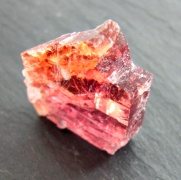 |
 |
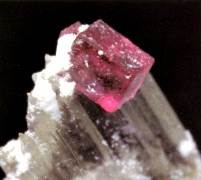 | |
| 宝石質のヴィヨーム石結晶片 17x10x4.5mm gemmy villiaumite crystal |
ヴィヨーム石(Villiaumite) 2.97ct 9.7x6.8mm |
透明なペクトライト結晶上のヴィヨーム石 Villiaumite 2mm on transparent Pectolite | |
| プードレット採石場 モン・サンチレール カナダ Poudrette Quarry, Mont Saint-Hilaire, Quebec, Canada | |||
ヴィヨーム石(ビリオム石 :
Villiaumite)
 |
 |
 | |
| 宝石質のヴィヨーム石結晶片 17x10x4.5mm gemmy villiaumite crystal |
ヴィヨーム石(Villiaumite) 2.97ct 9.7x6.8mm |
透明なペクトライト結晶上のヴィヨーム石 Villiaumite 2mm on transparent Pectolite | |
| プードレット採石場 モン・サンチレール カナダ Poudrette Quarry, Mont Saint-Hilaire, Quebec, Canada | |||
 |
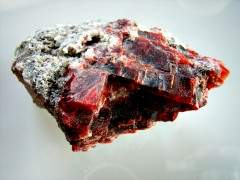 |
 |
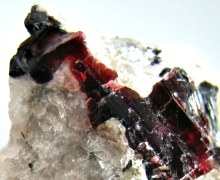 |
| ヴィヨーム石結晶(Villiaumite) 52x35mm 53x36mm Khibiny Heights, Kola Peninsular, Russia |
ヴィヨーム石(Villiaumite) 25x20mm 右は結晶部分拡大写真 Mont Saint Hilaire, Quebec, Canada | ||
| 化学組成 (Composition) |
結晶系 (Crystal System) |
結晶形 (Crystal Form) |
モース硬度 (Hardness) |
比重 (Density) |
屈折率 (Refractive Index) | ||
| NaF | 等軸晶系 (Cubic) |
 |
 |
 |
2〜2½ | 2.79-81 | 1.33 |
名前と産状(Name and Occurence)
ヴィヨーム石は20世紀初めに赤道ギニアの首都コナクリ沖合のロス諸島にて発見されました。
鉱物名は発見者であるフランス植民地軍の砲兵隊将校であり,旅行家でもあったシャルル・マクシム・ヴィヨーム(Charles Maxime Villiaume)に因み1908年に命名されました。
日本名ビリオム石はフランス語の綴りをローマ字読みした誤った読みが定着してしまったものです。
弗化ナトリウムという化学組成の典型的なハロゲン鉱物です。
塩化ナトリウムからなる塩(岩塩)や弗化カルシウムからなる蛍石とよく似た特性を持っています。
岩塩や蛍石がありふれた鉱物で広範に発見されるのに対して、ヴィヨーム石は大変稀な鉱物です。
アルカリ成分に富む溶岩中に生成する鉱物ですが、産地は世界で10ヶ所足らずしか報告されていません
; ブラジル、ミナス・ジェライスのポソス・デ・カルダス、カナダのモン・サン・チレール、グリーンランド西部のナルサク、アフリカ赤道ギニア沖のロス島、ケニアのマガディ湖、ナミビアのウィンドホク、ロシア、コラ半島のヒビーヌイ高地やラヴォゼルスクのツンドラ地帯、シベリア、サハ州タルゴ川盆地やアルダン楯状地、アメリカ、ニュー・メキシコ州のペックス台地と、何故かいずれも地の果ての土地ばかりです。
好奇心に溢れた冒険旅行家によって発見されるべき運命であったと言うべきでしょう。
Villiaumite was named in 1908 after French explorer and officer in the colonial artillery corps, Maxime Villiaume, who discovered this mineral at Los Islands near Conakry, capital of Guinea, Africa. Villiaumite belongs to halogenoid mineral and resembles Halite(rock salt : NaCl) and Fluorite(CaF). While latters are popular minerals and abundant, villiaumite is quite rare and only less than 10 world's localities are reported ; Poços de Caldas, Minas Gerais, Brazil, Pecks Mesa, New Mexico, U.S.A., Mt. St.-Hilaire, Quebec, Canada, Khmas Region, Windhoek, Namibia, Lake Magadi(South Lift Valley), Kenya, Los Archipelago, Guinea, Telemark, Norway, Narsaq, West Greenland, and Khibiny Massive and Rovozerk Tundra in Kola Peninsular and Aldan Shield, Targo River Basin, Sakha, Siberia, Russsia, all locations are alkarine rich igneous rock areas, in the remote area of the earth and it is not surprising that villiaumite was first discovered by an curious explorer.
稀な鉱物ではありますが、美しい色合いのせいでしょう、ロシアのコラ半島産の標本を、時には宝石質の3cmほどの大きく透明な結晶を鉱物フェアで時々見かけることがあります。
しかしカットされたルースにはついぞお目にかかる機会はありませんでした。
モース硬度が2と爪で傷が付くほど柔らかい上に[001][100][010]と即ち結晶の全方向に完全劈開するためカットは極めて困難と言うより殆ど不可能と言えましょう。
したがってルースは無理かと諦めていましたが、冒頭のカナダのモン・サン・チレール産をカットしたルースを入手しました。
ヴィヨーム石はモース硬度や劈開特性がほぼ塩の結晶と同じで水溶性です。
一般に宝石は研磨の際の摩擦熱を逃がすために水を流しながらカットします。
水溶性の鉱物の場合は水の代わりに特殊な油を使いますが、比熱が水の半分以下と小さいために摩擦熱が高くなり、カットの際には細心の注意が必要です。
その仕事を成し遂げたのはアメリカの "Coast to Coast Rarestone International"という、主に稀少石専門のカッター達の集団です。
私の集めたユージアル石、アウゲライト、蛍石、方解石等、カットが困難な稀少石の多くは彼らの手になるものです。
彼らがカットした最大のモン・サンチレール産のヴィヨーム石は16カラットとのことです。
コラ半島産は色が濃すぎる上に大きな石は透明度に欠けるのだそうです。
ようやく入手したルースですが、極めて柔らかくピンセットでつまむのは危険です。
その上水溶性で有毒ですから、直接触ることも出来ません。
かつてほぼ赤道直下のパナマで暮らしていた頃(雨季の8ヶ月間は湿度がほぼ100%という気候ですから)鉱物フェアで買った綺麗なピンクの岩塩の結晶が気が付いたらすっかり溶けてなくなり、箱に赤い染みだけが残っていたことを覚えています。
ヴィヨーム石も指で触れた部分が湿気で部分的に溶けてくる可能性が大きいのです。
乾燥剤を敷き詰めた密封した瓶に保存して、ただただ眺めるだけ、箱入り娘のような宝石です。
Although rare, perhaps because of attractive color and transparent crystal, specimen, mainly from Kola Peninsular are often available at mineral shows. However faceted stones are rarely seen. Due to low Mohs hardness of 2(easily scrathed by finger nail) and has perfect cleavage to [001][100][010] directions and water solubility, faceting is almost impossible. Most of rare stones from Mont Saint Hilaire are faceted by Coast to Coast Rarestone International - A highly skilful cutter groups in U.S.A. and Canada. The largest villiaumite from Mont Saint Hilaire, they faceted was as large as 16ct. They also faceted villiaumite from Kola Peninsular, which tends to be too dark and lesser quality - personal communication.
世界のヴィヨーム石(World's Villiaumite)
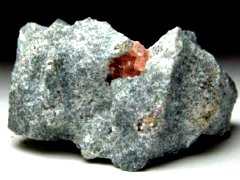 |
 |
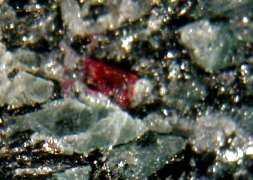 |
 |
| ヴィヨーム石結晶 48x40x28mm 右は結晶部分の拡大写真 Villiaumite crystal and magnified photo Aris Quary, Windhoek, Namibia Photo Courtsey : Mineral Street |
灰緑色のナンジャカス石内の ヴィヨーム石 4mm (Red Villiaumite in greenish-gray Nanjakasite:Na5(Fe++,Mn)Al4Si8O26) Narsaq River, Greenland |
霞石閃長岩中のヴィヨーム石 幅3mm Villiaumite in Nepheline Syenite ギニア ロス諸島 (Los Islands, Guinea) | |
市場で目にするヴィヨーム石は主にロシア・コラ半島のヒビーヌイ高地産のものが大半です。
その他、カナダのモンサンチレールやナミビア産が近年市場に流通するようになりました。
一般にアルカリ噴出岩の母岩中に小さな団塊状で発見され結晶形を示す標本は大変稀です。
冒頭の写真と結晶形の図にあるようにモン・サンチレールからは稀に2−10mmの大きさの6面体-8面体とその複合体を示す結晶が発見されます。
グリーンランド・イリモーサクのアルカリ岩貫入地帯であるクヴァネフィヨルドからも0.1−0.4mmと小さいながら結晶形を示す結晶が何個か発見されたことがあります。
モンサンチレールでもヴィヨーム石はかつてはごく小さな破片が発見されるだけでした。
しかし1982年にプードレット採石場が開発されるようになると霞石ー閃長岩脈中のソーダライトの1−10cmの晶洞中に一連の珍しい鉱物群を伴ってヴィヨーム石が発見されるようになりました。
1988年には15cmもの結晶が晶洞中に発見されましたが、取り出す際の衝撃で砕けてしまいました。
Most of villiaumites seen in the mineral markets, mainly from Kola Peninsular, Russia, are aggregates found in cavities of igneous rock ; nepheline syenite. Prior to 1982, villiaumite was very rare at Mont Saint-Hilaire, seldom encountered by collectors in more than small cleavage fragments. Since 1982, however, quarry operations have exposed villiaumite-rich sodalite xenoliths in small cavities in the sodalite and in surrounding nepheline syenite, associated with a very interesting and extensive suite of minerals at the Poudrette quarry. In 1988, a crystal exceeding 15cm across was reported in a cavity of solid villiaumite. This crystal did not survive the process of removal.
ヴィヨーム石の色について(Color of Villiaumite)
ヴィヨーム石の主成分弗素とナトリウムとはいずれも発色成分ではありません。純粋な結晶は無色の筈です。
しかしながら世界のどの産地であれ無色はありません。いずれもピンクから淡い橙、濃い朱色と同系統の色合いです。
即ちヴィヨーム石の発色には共通の原因があるのは間違いありません。ヴィヨーム石の発色についての資料もまた詳細な不純物の分析もありません。
したがってあくまでも推測でしかありませんが、おそらく蛍石の発色同様にppmの単位で含まれるごく微量のランタノイド系の希土類元素の不純物による発色と考えます。
ヴィヨーム石の色合いからはユーロピウム、プラセオジム、サマリウム、テルビウムやディスプロシウム等が関与している可能性が高いと思われます。
Villiaumite is intrinsically a colorless mineral. However, specimens from any world's localities are found commonly with pink to pale reddish orange and deep carmine colors. This fact tells that villiaumite is colored by same mechanism. Although there are no explanations nor detailed analysis of impurity in literature, the coloring mechanism is seemingly same as that of fluorite ; minor impurity of lantanoid series rare earth elements in ppm order, great probably Europium, Praseodymium, Samarium, Terbium and Dysprosium.
モン・サンチレール(聖イレール山): Mont Saint-Hilaire, Quebec, Canada
カナダのケベック州都、モンレアル(モントリオールは英語読み)の真東40kmに位置する標高415mの聖イレール山は日本ではモン・サン・チラールと誤った表記が多いのですがモン・サンチレールがフランス語の正しい発音です。
地名は紀元4世紀フランスのポワチエ出身の司教、聖イレールに因みます。
カトリックの根源である神とその子キリストと精霊との三位一体の教義の確立に貢献した聖イレールの名の教会や地名は各地に存在します。
奇しくもイタリア・エルバ島のペグマタイト鉱脈で有名なサン・イラリオも聖イレールのイタリア語読みの地名です。ただし同一人物かどうか?こちらは5世紀半ばにローマ・カトリック教会の教皇となったサルディニア島出身の聖イラリオかも知れません。
ここの採石場からおよそ世界の鉱物種4000種余りの1割近い357種を産します。
しかも新種のみで47種、未知の鉱物が数十種あり毎年その数が増えてゆきます。
さらに既存の鉱物でも他の産地では見られない大きく美しい多彩な宝石質の結晶を産する驚異の鉱物産地です。
鉱物の他に200種の動物、45種の哺乳類、200種の鳥類、800種の蝶、600種類の樹木と豊穣な自然により、世界屈指の自然のサンクチュアリとして有名です。
Mont Saint-Hilaire lies 40km east from Montreal. The mineral riches of Mont Saint-Hilaire is known throughout the world. The reputation rests on the quality, quantity (357 species with 47 new and over 50 unknown species yet to be identified) and diversity of cryastals by color, transparency and size, that have never been found in other localities in the world.
The mountain is famous not only with exceptional richness of mineral specimens, but also for the astonishingly rich species of the nature ; 200 animals , 45 manmals , 200 birds, 800 butterflies, 600 vascular plants etc. etc. Mont Saint-Hilaire is the 1st Biosphere in Canada.
モンサンチレール山南東部 右奥北東部が採石場
Mont Saint-Hilaire seen from south-eastern part
Poudrette Quarry is seen on the upper rightモンサンチレール (No,4) と周囲の貫入岩体
Intrusive bodies in the Mont Saint-Hilaire areaモン・サンチレール貫入岩体の地質図
Geology of The Mont Saint-Hileire intrusive complexモン・サンチレールはオルドヴィス紀(4.44−4.88億年昔)の頁岩と石灰岩からなる地層にそれぞれ1億3300万年、1億2200万年と1億2000万年昔と3度に亘る異なる性質の深成岩の貫入によって出来た直径およそ3kmほどの岩山です。
採石場は山の北東部端にあります。
左の図のように周囲に同様の貫入岩体が10ヶ所ほどあり、いずれも特異な鉱物産地として知られています。
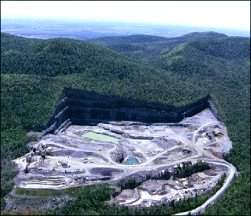 |
 |
 |
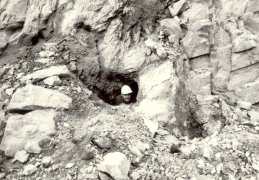 |
| プードレット採石場 Poudrette quarry |
現在は廃鉱となったドゥミックス採石場東部 左側の壁がプードレット採石場との境界 The eastern portion of Demix Quarry showing the wall(left) which separates the Poudrette and Demix quarries |
ペグマタイト晶洞 1989年 Pegmatite pocket exposed in 1989 |
驚異の発見となったペグマタイト晶洞 1988 The most exciting find of pocket |
世界屈指の鉱物産地ではありますが、モン・サンチレールがそれと知られるようになったのは意外と新しく1960年にセメント材の採石場が開発されたためでした。
地元の鉱物愛好家が採った鉱物の鑑定ををモンレアル大学の鉱物学教室に依頼したことが発端となり、ここが世界でも類を見ない稀少鉱物の宝庫であることが知られるようになりました。
同様な地質はロシア・コラ半島のヒビーヌイ山地とラヴァゼロ・ツンドラ地帯、ノルウェーのランゲスンドフィヨルド、グリーンランド南部のイリモーサクとイガリコ(ナルサルスク)複合体地帯と赤道ギニア・ロス諸島のルーム島等、世界に数えるほどしかありません。 いずれも同種の鉱物を産します。
モン・サンチレールでは古生代・オルドヴィス紀の堆積岩層に1億3300万年ー1億2000万年昔の間の3回にそれぞれ種類の異なるアルカリ性の深成岩の貫入にる変成作用によって多彩な鉱物が生成されました。
上の地図に示されているように、このような地殻変動は周囲の東西150kmに連なる10ヶ所にみられます。いずれも豊穣な鉱物産地ですが、とりわけモン・サンチレールでは際立って多彩で美しい鉱物結晶が報告されています。
最初に開発されたドゥミックス採石場で既に100種をこえる多様な新鉱物種が発見されましたが、1980年に新たに隣接するプードレット採石場が開発され、ここのペグマタイト鉱脈からはヴィヨーム石を初め、セラン石、レモンダイト、杉石、ペクトライト、ショータイト、ハックマナイト、クリード石等々、世界の他の鉱物産地とは全く異なる宝石質の大きく美しい結晶が次々と発見されました。
写真のように山のほんの一部が採掘されただけですから、今後さらに新たな発見が期待できます。
採石場での鉱物採集は年に何度か日を決めて有料での入場が可能です。
2006年は5月27,28日、7月22日、9月2日の4日間が採集日です。
Mont Saint-Hilaire, as mineral locality, has been known to the world relatively new in early 1960's. Since Demix quarry was opened, a local mineral collecor asked their identification of strange minerals to mineralogy class of Montreal University in 1964, then detailed studies of this quarry revealed this locality as one of the rarest type of alkaline complex rich with rare earth elements. Other well-known examples are the Lovozero and Khibiny massifs in the Kola Peninsular of Russia, the Langensund Fyord of Norway, the Ilímaussaq and Igaliko(Narssârssuk) complexes of southern Greenland and Îsle de Rouma, Los Archipelago, Guinea. The Mont Saint-Hilaire complex intruded the Paleozoic rocks of the St. Laurence lowlands during the Cretaceous period, approximately 125 millions years ago, as one of a series of 10 plutons known collectively as the Montregian Hills, which are strung out in an east-west linear fashion for a distance of approximately 150km. The mineral collections in this area is allowed only restricted days ; May 27,28, July 1st,22 and September 2nd in 2006.
モン・サンチレールの鉱物(Minerals of Mont Saint-Hilaire)
『Mineralogical Record誌 Jul-Aug1990』がモン・サンチレールの特集号としてその全貌を伝えています。; 透明度の高いヴィヨーム石を初め、冒頭の標本写真の透明なペクトライト、透明な杉石、魅力的な緑色の閃亜鉛鉱や淡紫色の曹長石、宝石質のセラン石、ショート石、マンガンタイカイト、色変わりを見せるハックマン石、同じく宝石質のバーバンク石等々、世界に例を見ない鉱物結晶の宝庫です。 |
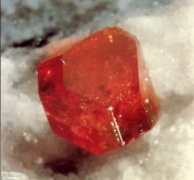 |
 |
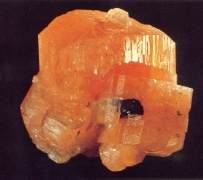 |
 |
| ユージアル石(Eudialyte) 1.5mm Horváth Collection |
方沸石中の方曹達石 1cm (Sodalite in analcime) Royal Ontario Museum |
セラン石(Serandite)
2.5cm Haineault collection |
Pectolite
4.5cm Haineault collection |
 |
 |
 |
| Genthelvite
3cm Haineault collection |
ソーダライト(ハックマナイト) 双晶 4cm Sodalite(Hackmanite) twin crystal 4cm B.Poudrette Collection |
Burbankite
6mm Horvach collection |
| Poudrette Quarry, Mont Saint-Hilaire, Quebec, Canada | ||
バーバンク石:(Na,Ca)2(Sr,Ba,Ce)3(CO3)5は1953年にモンタナ州で最初に発見され、その後世界各地の主にアルカリ成分に富む噴出岩地帯18ヶ所から報告されています。 |